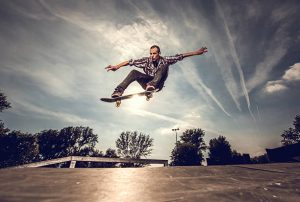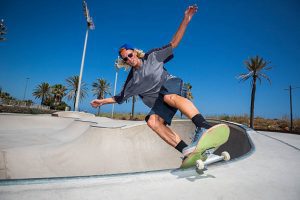Have you heard about skateboarding lingo? Skateboarding has its style of lingo and skateboarding terms.

It can be hard for outsiders (non-skaters) to decipher skateboarding terms and slang – but we’re here to help. In this article, we’ll dive deep into this guide on the world of slang and lingo for skateboarding. From its origins to common skateboarding terms, including trick names and how they’re used in context. We’ll explore how common skateboarding terms and slang shape skater identity and look towards the future of skateboarding – all with the aim of helping you understand skater talk and appreciate the richness and creativity of skateboarding culture.
At FamilyHype, we believe that skateboarding is more than just a sport, it’s a lifestyle and a community, and we invite you to join us on this journey as we explore the slang of skateboarding. Whether you’re a curious outsider or a newbie skater eager to speak the lingo, buckle up – it’s going to be a wild ride that will leave you stoked, excited, and all sorts of happy!
The Origins Of Skateboard Lingo
Ever wondered where all that gnarly skateboarding lingo comes from, dude? Let’s cruise through the origins of skateboard slang together! Skateboarding slang development began with trailblazing pavement pioneers. Influential skateboarders in language formation created a unique skate vernacular to establish camaraderie and communicate skateboard tricks.
This cool skate slang came straight from the heart of the skating community. Ready to drop into some common skateboarder terminology? Hang ten, because we’re about to shred some serious linguistic concrete! So let’s get shredding and explore the origins of skateboarding lingos together!
Common Skating Slang Terminology
If you want to be part of the skateboarding community, you need to know the essential terms of the skateboarding lingo. It’s not just about skateboard tricks; it’s also about fashion, dialects, and respect. At FamilyHype, our writers and editors value the family unit, and that extends to the skate park. So let’s talk about the world of skateboards and their tricks!
Skater fashion slang is a must-know – think ‘thrasher’ and ‘grip-tape’. Then there are regional skateboarding slang, which can vary from coast to coast. It’s important to be respectful and inclusive in our lingo when we talk shop, and that’s something the skate community values. Common skater slang terminology includes words like ‘gnarly’, ‘stoked’, ‘sketchy’, ‘deck,’ ‘grind,’ ‘slam,’ ‘acid drop,’ ‘grip tape,’ ‘quarter pipe,’ ‘flat bottom,’ and terms related to scraping an obstacle with the trucks.
As a skater, it’s also important to understand the basics of skateboard safety, learning to fall, the importance of protective gear, and the effects of skateboard culture on the community. We’re here to help you understand the world of skateboarding and how to be part of the community. So grab the nose of the board and let’s get rolling!

Trick Names
So you’ve decided to dive into the exciting world of skateboarding tricks, huh? Well, prepare to be amazed by the gravity-defying stunts and their equally fascinating names. Skateboarding is a complex and creative activity that involves a combination of skill, gear, and expression. From ollies to kickflips or skater flips, each trick is a unique combination of the top board, nose of the board design, and the rider’s technique.
Also, skateboard performs tricks and their names include the indy grab, performed by skateboarders on a flat surface or a U-shaped ramp, where the rider skates with their right foot and uses the skateboard truck to grab the skateboard’s edge in the skatepark, showcasing skating styles such as skating on a huge vert ramp or adopting a unique skateboarding style.
Other examples of skateboard tricks and their names include riding fakie, bail, kick turn, and grab trick, with examples like crooked grind and tail slide, as a young skateboarder in a skate crew performs skate tricks on a mini ramp or urban sport setting, with landing bolts being crucial, and the trick invented by skaters like Rodney Mullen often involving the skater’s left foot forward and foot remaining on the board’s vertical axis.
As you explore this world, you may encounter a variety of skateboard tricks and their corresponding dialect. Here at FamilyHype, we encourage you to try out new tricks and share your experience with us. We hope you learned something new about skateboarding tricks and their names. As you continue your journey, FamilyHype would love to hear about your progress.
Skateboarding Slang And Lingo
Understanding skater terms in context involves grasping concepts like gap jumps, opposite directions, rider grinds, and vert ramps within the skating culture. Navigating the world of skater jargon isn’t just about knowing the words – it’s about truly grasping their meaning and using them correctly in context. The following are some common skateboarding slang terms that you might encounter, along with their meanings:
- Ollie: An ollie is a fundamental trick where the rider pops the tail of the board on the ground with their back foot while simultaneously sliding the front foot forward, causing the board to leap into the air. This forms the basis for many other tricks. You can watch instructional videos for more information.
- Kickflip: A kickflip is a trick where the board spins along its length while in mid-air. The rider uses their goofy foot to kick the board, causing it to flip and rotate before landing back on the grip tape with their front foot, often taking one foot off the board in the process.
- Grind: Grinding involves sliding the trucks (axle assemblies) of the longboard along an edge or rail, and navigating an obstacle with the trucks. This can be done on various surfaces, like handrails, curbs, or ledges.
- Vert: Short for “vertical,” vert refers to riding on ramps or halfpipes with steep inclines, allowing riders to perform aerial tricks.
- Street: Street skating involves performing tricks & maneuvers in urban environments, such as on stairs, rails, ledges, & other street furniture. Learning to trick perfectly in the streets takes time but it can be done. Learning to trick perfectly in the streets takes time but it can be done.
- Pop: The term “pop” refers to the amount of force or energy a rider puts into their ollie or other tricks to achieve height & control.
- Nollie: Similar to a nose ollie, a nollie is a trick where the rider pops the nose of the longboard with their front foot while jumping, causing the board to lift off the ground with the front end first.
- Gap: A gap is a space or distance between two surfaces that riders jump over, often performing tricks while airborne. The term “gapping” describes clearing the distance.
- Manual: A manual is a balance-based trick where the rider maintains balance on either the front or rear wheels while keeping the other set of wheels and one foot off the board.
- Stance: Stance refers to the way a rider positions their feet on the board. A regular stance means the left foot is forward, while a goofy stance means the lead foot is forward.

Pop Shove It And Other Tricks And Lingo
Skateboarding is a canvas for a multitude of tricks that blur the lines between athleticism and artistry, especially when you grind a trick. Beyond the well-known tricks like the pop shove-it, where the skater spins the skateboard 180 degrees while jumping, there’s a plethora of creativity to explore. From technical maneuvers like darkslide, a trick that means landing reverse-side-up on your skateboard deck, or manipulating the front foot to control the skateboard’s trajectory to fluid skater slides and daring skater grabs that redefine gravity, the possibilities are endless. All these tricks will surely make you stoked, excited, and hungry to learn more!
Riding skateboards isn’t just about the back foot; it’s about the connection between every inch of the skateboard deck and the skater’s intuition. A half skateboard might seem unconventional, but it’s the perfect platform for innovative skate tricks that challenge convention. Complete skateboarding is the opposite but you will definitely enjoy riding a U-shaped ramp to do your skateboard tricks. Other skate tricks include aerial skateboard tricks where the skateboarder flips in the air.
Lingo And Identity
Diving deeper into the world of skateboarding, let’s explore the powerful role lingo plays in shaping skater identity. Terminologies play a crucial role in skater identity by creating a unique language for tricks like smith grind and pivot cup, fostering communication among skaters on flat ground, vertical ramps, and half pipes, and allowing them to express individuality in their lingo, which sets them apart from other skaters.
Language acts as a cultural identifier within our community, creating bonds and shared understanding among us, especially when we grind a trick together with our wheels. It’s fascinating to observe how our unique lingo shapes and reflects the distinct culture we’ve built around this thrilling board sport. Language plays a crucial role in shaping skater identity, serving as a bridge between the act of skateboarding and the distinct culture that surrounds it. Skateboarders often communicate their passion through a lexicon that’s intimately tied to their actions on the skateboard, especially the tail of the board.
From vivid descriptions of grind trick performed with technical precision to riding and gear demonstrations that involve manipulating the tail or nose of the board, lingos become a canvas for conveying the intricate artistry of skateboarding obstacle. Terms like “ollie,” “kickflip,” and “grind” encapsulate the essence of skateboarding, evoking the rush of energy that comes with executing tricks flawlessly. Whether it’s the tactile details of a skateboard deck’s plywood or the mechanics of a skateboard truck’s hanger, skaters have a linguistic code to narrate their experience.
This lingo doesn’t merely describe the people who perform tricks. It embodies the shared thrill of downhill skating, the sense of community, and the profound connection between skaters who often grind a trick on their boards, particularly the tail of the board. It’s an awesome thing, a reflection of a perfectly executed trick, and a reminder that for skateboarders, language is an integral part of the ride itself.
Lingo As A Cultural Identifier
In the skater community, you’ll quickly discover that lingo serves as a powerful cultural identifier, with its unique vernacular intricately tying together the shared experiences and values of its members. Skater dialect regional variations can even influence skater fashion trends.
- Understanding this distinct slang, similar to understanding the tail of the board, allows us to better connect with and serve this dynamic group. At FamilyHype, we understand the importance of the culture & how lingo plays a pivotal role in shaping it. We appreciate the community’s values & its unique identity & are dedicated to helping provide support, information, & resources to enhance & strengthen the skateboarding experience.
- The skateboarding culture has its own unique identity & lingo that sets it apart from the rest. Riders often use slang like ‘gnarly,’ ‘sick,’ & ‘stoked excited’ to express their enthusiasm & excitement about the sport. Riders also have their own fashion trends that are heavily influenced by their regional kickflip dialects.
- For example, riders on the West Coast may wear baggy jeans or bright, neon colors, while riders from the East Coast may opt for a more classic look with a hoodie & jeans. By understanding these subtle nuances of the culture, we can better serve the community & provide them with the resources they need to succeed.
- At FamilyHype, we recognize the importance of this sport in the modern world & the power of lingo as a cultural identifier. We value the commitment to self-expression, creativity, & individuality, & we strive to provide meaningful & supportive content, resources, & experiences that celebrate the community.
We invite you to share your opinions and experience and help us make the skateboarding experience even better.

How Lingo Shapes Culture
- You’d be amazed at how much the culture is shaped by its unique slang. FamilyHype, the website publishing this content, recognizes the undeniable influence of lingo on skateboarding, and how it strengthens bonds & fosters a sense of belonging.
- This lingo development enhances creativity, solidarity, and individuality, making our family stronger, more diverse, & more inclusive.
- This lingo has a unique flavor that enhances the culture & encourages individuality. Through this lingo, creativity is fostered, solidarity is strengthened, & the future of the sport is propelled forward.
- This lingo shapes the culture as riders perform tricks, making use of their own language, on features like a vertical ramp or half pipe.
- Common terms like “switch stance”, “tail of the board”, “front truck”, “front foot”, “nose the front”, “wheels to the deck” & many more make sense to riders and within the community simply because it was created specifically for skateboarding and describes the trick or parts perfectly.
The Evolution Of Skateboarding Terms
As we trace the evolution of skateboarding lingo, it’s exciting to think about the future of this vibrant subculture, street skating, and the unique dialect that comes with it. At FamilyHype, we strive to provide a platform for skateboarders to connect and understand each other, and to celebrate the diversity of skateboarding. Skateboarding culture includes not only skateboarders, but also core shops, skate parks, and other skateboarding-related board entities.
With the help of the latest skateboarding lingo, we anticipate enhancing communication within this community. From skateboard deck and trucks to wheels and bearings, the skateboarding vocabulary is ever-evolving and we look forward to seeing how the lingo continues to develop and grow.
We invite all skateboarders, parents, and enthusiasts to share their thoughts and experiences with us, as we strive to foster understanding and unity within the skateboard community.
Conclusion
We’ve dived into the dynamic world of skateboarding slang, exploring its roots, common terms, and trick names. From ollies and kickflips to grinds and skateboard deck slides, skateboarders have been able to express themselves through their language. We’ve also understood how skater lingo defines their identity and how it continues to evolve.
While it may seem complex at first, with time we’ll all be speaking like a seasoned skater in no time! Skateboarding language is more than just words; it’s an invitation to join and understand a unique culture of skateboarding. At FamilyHype, we recognize the importance of understanding skateboarding culture, and we want to help equip you with the knowledge you need to connect with it.
Keep shredding and let us know how you’re enjoying the journey!
Frequently Asked Questions (FAQs):
What Is Another Word For A Skateboard?
The slang word for skateboard is often simply ollie board or deck.
What Is The Importance Of Grip Tape?
Grip tape is important in skateboarding because it provides traction and grip on the skateboard deck, enhancing the rider’s control and stability during maneuvers and tricks.
How Do You Talk Like A Longboarder?
To talk like a skateboarder, use terms like “skater lands,” “foot hanging,” “skateboard’s trucks,” “skaters perform,” “tail end,” “features smooth transitions,” “foot forward,” and “rider performs moves” and many more. Use skate slang and terminology, reference popular tricks or spots, and embrace the casual, laid-back tone common among skateboarders.
What is skate slang?
Skate slang refers to the informal language and jargon used within the skateboarding community and its high words. It includes terms for skateboard tricks, equipment, and expressions unique to skateboarders.
What is a skater guy slang?
Skater guy slang could refer to the specific jargon and expressions used by male skateboarders.
What are decks?
In skateboarding slang, “decks” often refer to skateboard decks, the flat wooden skateboards that skateboarders stand on.
How do you compliment a young skater?
Compliment the young skater by acknowledging their skate skills in performing a raised-edge transition trick, like an anchor grind, where they navigate the skateboard mid-air with impressive control and style, showcasing their creativity as a skateboarder at a skateboarding event. You could say something like “Your skate tricks are sick!” or “You’ve got a rad sense of balance.”
When can you call yourself a skater?
You can call yourself a skater when you engage in activities like vert skating, perform grab skateboard tricks, sliding tricks, crooked grinds, and utilize inline skates, with the skater pushing or her feet remaining on a U-shaped skate ramp featuring various maneuvers to describe skating. You can call yourself a skater if you regularly engage in skateboarding, identify with skate culture, perform tricks using your front foot, and embrace its values and lifestyle.
What does cheapskate mean?
“Cheapskate” is slang for someone unwilling to spend money, especially on others, and is often used playfully or teasingly.
What does the idiom “skate by” mean?
The idiom “skate by” means to barely manage or succeed at something without much effort or attention. It implies getting through a situation with minimal involvement or difficulty.
Last Updated on July 7, 2024 by Nisa Jabajab
DISCLAIMER (IMPORTANT): This information (including all text, images, audio, or other formats on FamilyHype.com) is not intended to be a substitute for informed professional advice, diagnosis, endorsement or treatment. You should not take any action or avoid taking action without consulting a qualified professional. Always seek the advice of your physician or other qualified health provider with any questions about medical conditions. Do not disregard professional medical advice or delay seeking advice or treatment because of something you have read here a FamilyHype.com.